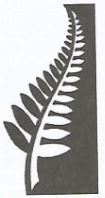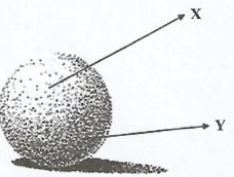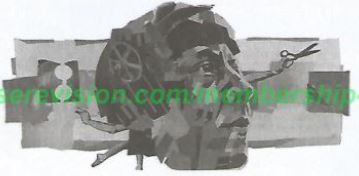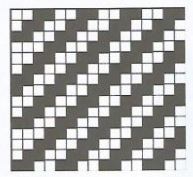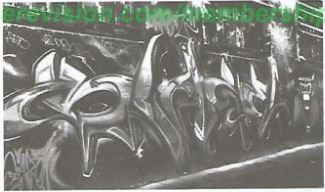SECTION A (20 marks)
Answer all the questions in this section in the spaces provided.
-
- Distinguish between the two types of space used in the illustration below. (2 marks)
- Explain how pattern is used to create rhythm in a work of art. (2 marks)
- Name two tools used in oil painting technique. (2 marks)
- List two types of ornaments worn around the arms. (2 marks)
- The table below consists of painting media and their respective binding substances. Complete the table by filling in the missing medium and binding substances.
Medium Binder 1 (1⁄2 mark) Egg Yolk 2 Water colour (1⁄2 mark) 3 Acrylic paint (1 mark) - Identify two uses of line in graphic design. (2 marks)
- Highlight one reason why paraffin wax and beeswax are mixed during batik process. (2 marks)
- Distinguish between a monochromatic colour scheme and an analogous colour scheme. (2 marks)
- Analyse the illustration below and label the parts marked X and Y. (2 mark)
- Study the artwork below and state the technique used to produce it. (2 marks)
- Distinguish between the two types of space used in the illustration below. (2 marks)
SECTION B (25 marks)
Answer all the questions in this section in the spaces provided.
-
- Highlight one limitation of using wood as a material in sculpture making. (1 mark)
- State two reasons why grog is added to clay. (2 marks)
- Explain the term assemblage as used in sculpture. (2 marks)
- The diagram below represents a technique in weaving.
- Identify the technique. (1 mark)
- Explain two characteristics of the weave structure. (2 marks)
- Outline the process of making the weave. (2 marks)
- The image below is a work of art.
- identify the type of artwork (1 mark)
- State two tools used in the execution of the artwork. (2 marks)
- Explain the challenges faced by the artists associated with the artwork. (2 marks)
- Outline and discuss the five states of clay during pottery making process. (5 marks)
- In the space provided below, construct the word ''design'' in calligraphy. Indicate the ½ x-height and x-height. (5 marks)
SECTION C (15 marks)
Answer any one question in this section in the space provided after question 9.
-
- Outline two uses of display panels and props during an art exhibition. (2 marks)
- Identify three factors to consider when displaying artworks at an exhibition. (3 marks)
- Explain the process of drawing a townscape from observation using a view finder. (10 marks)
-
- State two functions of a frame in silk screen printing. (2 marks)
- Light sensitive solution is used in a screen printing process.
List two other substances that can be used to block the mesh before printing. (2 marks) - Discuss the process of preparing a screen for printing using any one of the substances mentioned in 8(b). (11 marks)
-
- Distinguish between mosaic and montage as picture making processes. (2 marks)
- Point out two functions of using fixatives in pencil drawingship-join/ (2 marks)
- Outline the steps of making a pictorial composition using a combination of montage and painting. (11 marks)
MARKING SCHEME
SECTION A (20 marks)
-
- Distinction between the two types of space used in the illustration;
NamingPOSTIVE SPACE NEGATIVE SPACE Area occupied by the shapes. In this case black leaves Empty spaces surrounding the shapes or object (white areas)
Distinction = 1⁄2 mark
Total = 2 marks - How pattern is used to create rhythm;
- By alternating the different shapes or elements
- Inserting spaces between elements
- Repetition of different patterns Any 1 x 22 marks
- Two tools used in oil painting technique;
- Pallete knife
- Brushes
- Air brush Any 2x 12 marks
- Two types of ornaments worn around the arms
- Armlets
- Bangles
- Arm ring
- Arm bracelets Any 2 x 12 marks
- Missing medium and binding substances of painting media.
Total = 2 marksMedium Binder 1 TEMPERA (1⁄2 mark) Egg yolk 2 Water colour GUM ARABIC/ SYNTHETIC GLUE (1⁄2 mark) 3 Acrylic paint SYNTHETIC BINDER (1 mark) - Two uses of line in Graphic design;
- Constructing letters
- Add style
- Enhance comprehension
- Create forms
- Divide space elements Any 2 x 1 = 2 marks
- One reason why paraffin wax and beeswax are mixed during batik process:
- To regulate the cracks achieved since beeswax is soft, pliable and blocks completely (no cracks)
- Paraffin wax is more brittle and lets dye penetrate wherever cracks form 2 x 1= 2 marks
- Distinction between monochromatic colour scheme and analogous colour scheme;
2 x 1 = 2 marksMonochromatic colour scheme Analogous colour scheme Uses variations in lightness and saturation of a single colour Uses colour that are adjacent to one another on the colour wheel. - Labelling the parts marked X and Y on the given illustration;
- X is the highlight
- Y is the core shadow or shadow edge 2 x 1 = 2 marks
- Technique used to produce the artwork is montage 2 x 1 = 2 marks
- Distinction between the two types of space used in the illustration;
SECTION B (25 marks)
-
- One limitation of using wood as a material in sculpture making;
- Errors when carving are not easy to correct in wood
- Wood has poor dimensional stability i.e. it shrinks, swells, splits, warps etc. Any 1 x 1 = 1 mark
- Two reasons why grog is added to clay;
- Reduces shrinkage Reduces plasticity
- Strengthens the clay
- Improves texture
- Aides in drying
- Prevents cracking Any 2 x 1-2 marks
- Explanation of term assemblage as used in sculpture;
Is a sculpture making method that involves e of non-art materials, often found objects that are assent Page2ough various technique such as welding, gluing, soldering, riveting etc. 2x1 = 2 marks
- One limitation of using wood as a material in sculpture making;
-
- Identifying the weaving technique
- 2/2 twill weave 1 x 1= 1 mark
- Two characteristics of the weave structure;
- The offset of each raw form a diagonal pattern
- The right and wrong side of the weave structure appear identical. Any 2 x 1 = 2 marks
- Outline of the process of making the weave;
- First row; starting from right to left, insert the weft; under two warps over two, under two over two, under two over two, under two
- Repeat the sequence until completion of desired weave size. 2 x 1 = 2 marks
Total = 5 marks
- Identifying the weaving technique
-
- Type of artwork is; graffiti 1 x 1 mark = 1 mark
- Two tools used in execution of the artwork:
- Air brush
- Spray cans
- Etching tools Any 2 x 1 = 2 marks
- Challenges faced by the artists
- Art type is not legal, artists have to seek authority from property owners
- It is an expensive activity because the tools required are expensive
- It has health risks associated with inhalation of the toxic fumes.
- hard to reach locations which offer high visibility and are a risk on the part of those placing the graffiti
- Negative criticism Any 2 x 12 marks
Total = 5 marks
- Outline and discussion of five stages of clay in the pottery making process;
State of clay each 1⁄2 mark x 5STATE OF CLAY DISCUSSION 1. Dry clay stage Made up of fine particles formed from volcanic ash, e.g. Ball clay, kaolin, china clay, red clay, fire clay, etc. 2. Slip clay stage Created by adding water to clay. It is used to hold the clay together when attaching handles, hand building, decorating clay wares and for moulds. 3. Plastic stage/Green ware This is clay that is flexible or malleable and is able to create an article either by hand building or using a wheel. 4. Leather hard stage This is clay that is hardened a little and articles can still be trimmed, handles added and alterations made 5. Bone dry stage This when the moisture is out of the clay and its dry enough 6. Bisque ware stage Is when the clay is fired in a kiln between cone 08 (973°) and cone 4 (1060°) to remove chemically bonded water and impurities.
Discussion of each state = each 1⁄2 mark x 5
TOTAL = 5 marks - Constructing the word "design" in calligraphy indication 1⁄2 - X height and X-height;
- 1⁄2 X-height = 1 mark
- X-height = 1 mark
- 1⁄2 X-height = 1 mark
- word correctly written in calligraphy = 2 marks
Total = 5 marks
SECTION C (15 marks)
-
- Two uses of display panels
- Holding 3D artworks during exhibitions
- Pinning up 2D artworks Any 2 x 1 = 2 marks
- Three factors to consider when displaying artworks at an exhibition:
- Spacing
- Lighting
- Flow of artifacts (similar subjects should be displayed together).
- Mounting/ framing of the artworks.
- Labeling of the artworks (theme, artists name, date etc).
- Flow or route ways for the viewers to avoid congestion Any 3 x 13 marks
- Process of drawing a townscape from observation using a view finder:
- Step 1: Choose the view/ townscape Im
- Step 2: Size the drawing 1m to have the same ratio as that of the view finder picture plane
- Step 3: Hold the viewfinder at arm's length, 1m and look through the hole at the subject
- Step 4: Pick out the best view by moving the view finder frame in different directions, (up, down, sideways nearer or further) to focus on the area to be drawn1m. (Horizontally or vertically)
- Step 5: Decide on how much of the subject should be included in the drawing Im
- Step 6: Make a sketch of the drawing viewed through the hole of the view finder.
- Step 7: Divide the drawing into quarters,2m to make it easier to capture the layout of the landscape using the principles of 2D art as balance, perspective, movement etc.
- Step 8: Start drawing form the bottom right quarter1m
Steps sequentially outlined as highlighted = 10 marks
Total = 15 marks
- Two uses of display panels
-
- Two functions of a frame in silk screen printing:
- It holds the stretched silk mesh fixed on it,
- It acts as a dye well i.e. it holds the ink poured onto it before forcing it through during printing,
- To hold the design flat on the printing surface. Any 2 x 1-2 marks
- Two substances that are used to block out the mesh before printing apart from light sensitive solution;
- Ulano (hand cut film)
- Shellac
- Lacquer
- Varnish
- Sticker paper Any 2 x 1 = 2 marks
- Process of preparing a screen using any one substance mentioned in 8 (b);
- Step 1: Sketch the design,
- Step 2: Choose the colour scheme, ½m
- Step 3: Mark the positive and negative 1m areas in the design,
- Step 4: Stretch the mesh 1m onto the wooden frame starting from each of the four corners to ensure tautness. Staple the mesh, alternatingly Im until all the four sides are well fastened
- Step 5: Transfer design ½m onto the silk mesh using a light pen/chalk ½m
- Step 6: Block out the negative areas using either shellac, lacquer, varnish OR cut out the ulano film using a cutter, 2m
NOTE: for ulano film place the film beneath the silk mesh and using a solvent dipped in cotton wool, rub through to transfer the design onto the mesh. Let it dry and peel off the clear film. - Step 7: check for any pinholes against the light. Im Fill up any pinholes using either shellac, lacquer, varnish or ulano and let it dry, Im
- Step 8: Mask around the screen using brown tape or masking tape to prevent the dye paste/ink from penetrating into the unwanted areas during the printing process. Im
- Step 9: Mark registration marks on the screen/frame. 1m
Steps sequentially discussed as highlighted = 11 marks
Total = 15 marks
- Two functions of a frame in silk screen printing:
-
- Distinguishing between mosaic and montage as picture making processes;
Any 1 x 2 = 2 marksMOSAIC MONTAGE Uses cut out pieces of coloured or plain paper referred to as tesserae Uses cut out pictures Unintentional spaces are left in between the tesserae referred to as interstices Cut out pictures are superimposed to draw connections to previously disconnected images - Two functions of using a fixative in pencil drawings;
- Prevent smudging
- To allow addition of layers in shading
- To preserve finished artwork from dust
- To stabilize the graphite. Any 2 x 1 = 2 marks
- The steps of making a pictorial composition using a combination of montage and painting
- Choose a theme 1m
- Make appropriate sketches 1m
- Collect old newspapers and magazines 1m and cut out basic shapes of appropriate pictures. Im
- Prepare the support 1m and prime it to make it receptive to paint and to stabilize it
- Transfer the relevant sketches to the support 1m;
- Mark the areas 1m to be painted and where pictures are to be stuck
- Paint 1m using oil colours or acrylics and allow to dry 1m
- Paste the pictures 1m using a suitable adhesive in the relevant sections according to sketch and allow to dry. 1m
Correct sequence of steps as highlighted = 11 marks
Total = 15 marks
- Distinguishing between mosaic and montage as picture making processes;
Download Art and Design Paper 1 Questions and Answers - KCSE 2021 Past Papers.
Tap Here to Download for 50/-
Get on WhatsApp for 50/-
Why download?
- ✔ To read offline at any time.
- ✔ To Print at your convenience
- ✔ Share Easily with Friends / Students

